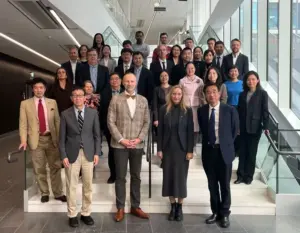
In a historic shift for Japan, Sanae Takaichi has become the nation’s first female Prime Minister, a milestone that resonates deeply in a country known for its male-dominated political landscape. Her ascent to power comes amid a backdrop of complex geopolitical tensions and domestic challenges, setting the stage for a transformative era in Japanese politics.
Takaichi’s leadership is marked by her commitment to bolstering Japan’s defense capabilities. Despite Japan’s pacifist constitution, which renounces war, the Self Defence Force now boasts nearly 257,000 active personnel, over 1,000 aircraft, and a formidable navy. Takaichi has pledged to increase defense spending to 2% of GDP, a move that aligns with her conservative stance and has drawn both support and criticism.
Personal Life and Political Stance
Beyond her political ambitions, Takaichi’s personal life is equally intriguing. She is married to Taku Yamamoto, a former politician, and stepmother to his three children. Their relationship, marked by a divorce and subsequent remarriage, reflects her complex personal narrative. Yamamoto, who is partially paralyzed, describes himself as a “stealth husband,” preferring to stay out of the limelight.
Politically, Takaichi is often compared to Margaret Thatcher, earning the moniker “Japan’s Iron Lady.” Her admiration for Thatcher’s toughness in a male-dominated world is well-documented. However, her policies, particularly regarding women’s rights, are seen as conservative. While she advocates for increased financial support for women, she opposes same-sex marriage and supports male-only succession within the royal family.
“The sight of a woman leading a government for the first time offers some hope for younger women that they may be able to make an impact in Japanese politics, and Japanese society.” – Adam Simpson, University of South Australia
Challenges and Criticisms
Takaichi’s tenure is not without its controversies. Her stance on the “fufu bessei” issue—allowing married couples to keep separate surnames—has drawn criticism from feminist circles. Despite suggesting a more gender-balanced cabinet, her appointments fell short of expectations, with only two women among 19 positions.
Economically, Takaichi’s policies mirror the stimulus-driven “Abenomics” of her mentor, former Prime Minister Shinzo Abe. Her approach includes government spending, tax cuts, and lowering interest rates, despite inflation concerns. However, her push for deregulating the labor market and extending working hours has sparked debate in a country grappling with “karoshi,” or death by overwork.
“Her failure would reinforce disappointment and frustration among women in Japan, seeing themselves disadvantaged in society.” – Sebastian Maslow, University of Tokyo
International Relations and Diplomatic Maneuvers
On the international stage, Takaichi has navigated complex diplomatic waters. Her meeting with former U.S. President Donald Trump resulted in a trade agreement that lowered tariffs on Japanese goods. Her diplomatic efforts have extended to ASEAN and APEC summits, where she engaged with global leaders, including a cautious meeting with China’s Xi Jinping.
Relations with China remain delicate, especially following Takaichi’s comments on potential military intervention in a China-Taiwan conflict. Her stance on hosting U.S. missiles and reducing trade dependency on China underscores her strategic priorities.
Domestic Policy and Future Prospects
Domestically, Takaichi faces significant challenges, including addressing labor shortages and managing Japan’s aging population. Her policies on immigration and tourism have sparked debate, as Japan grapples with maintaining its cultural identity amid increasing foreign influence.
“Her grip on power will depend on whether she can deliver that reform, which for most voters means lower living expenses more than anything else.” – Sebastian Maslow, University of Tokyo
As Japan’s first female Prime Minister, Takaichi stands at a crossroads. Her leadership will be tested by her ability to balance conservative values with the need for progressive reforms. Her success or failure will not only shape Japan’s future but also influence the global perception of women in leadership roles.






